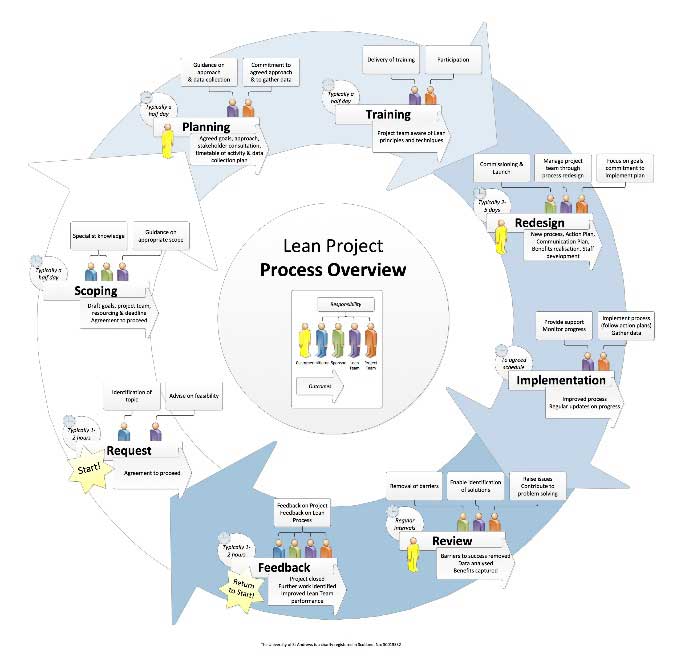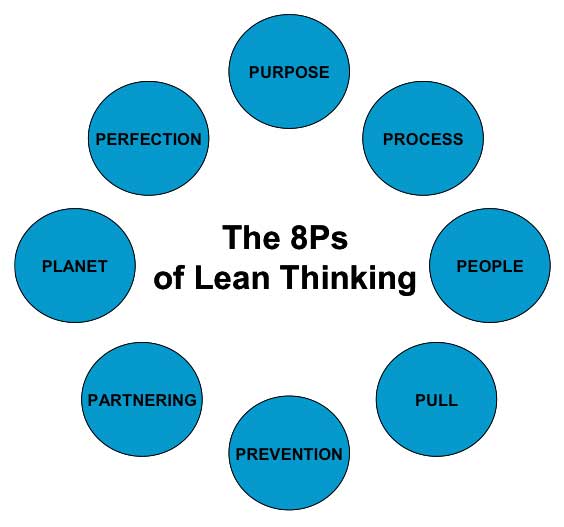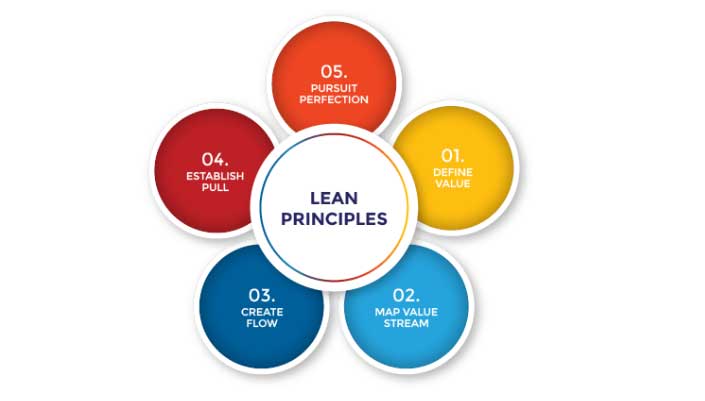Lean was born out of manufacturing practices but
in recent time has transformed the world of knowledge work and management. It
encourages the practice of continuous improvement and is based on the
fundamental idea of respect for people. Womack and Jones defined the five
principles of Lean manufacturing in their book “The Machine That Changed the
World”. The five principles are considered a recipe for improving workplace
efficiency and include: 1) defining value, 2) mapping the value stream, 3)
creating flow, 4) using a pull system, and 5) pursuing perfection. The next
sections provides a detailed overview of each principle.
Understanding the Basics – Lean Process
Improvement
If we are to understand the basics of Lean
process improvement let’s start with a review of the definition of Lean. We can
define Lean as a system for developing process improvement that is continuous
and has a focus on reducing and eliminating waste.
Toyota developed the concept to help with
their production operation and improve processes to cut the time it takes from
receiving an order to delivering it.
• You minimize waste when you use a Lean
approach.
• You look at value from the customer point of view and deliver what the
customer needs when they need it.
When you implement a Lean Process Improvement
approach an organization can:
• Minimize waste
• Reduce inventory
• Increase productivity
• Improve quality
• Increase customer satisfaction
• Reduce costs
• Increase profits
Lean Process Improvement can apply to
production environments but also extend to other environments such as
healthcare, software development, service, and government.
The ideal with Lean is to meet customer
expectations by creating a near perfect process. The process minimizes waste,
uses as few resources as possible, and encourages continuous improvement.

Some basics of Lean Processes:
To accomplish ideal Lean processes, here are
some of the techniques:
• look at the overall flow of products and
services
• do not focus only on separate technologies and departments but look at the
big picture
• look at all assets, technologies, and departments involved
• eliminate waste along the entire process not just separate points
Compared to a traditional approach a Lean approach can use less space, less money, and less time to make products and deliver services. For example, instead of keeping a large inventory of products, you have the inventory you need for your immediate orders. This approach can help you streamline your operations plus respond as customer preferences change.
Some misconceptions:
Lean is not just a way to reduce costs.
Instead, it is a way of thinking. It is not a short term solution. It is the
way a group operates. It is actually a long term approach that requires
discipline.
Lean is not just for manufacturing. Groups
outside of manufacturing have used a Lean approach and had good results. This
can include service groups, healthcare, and government.
A short history of Lean Process Improvement:
The term Lean appeared in the 1980s to
describe an approach Toyota was taking. Dr. Jim Womack of MIT and his team
coined the term. Womack and Jones wrote Lean Thinking where they described
basics of Lean organizations and characteristics of their supply chain.
Womack founded the Lean Enterprise Institute
while Jones founded the Lean Enterprise Academy. Their book describes the
thinking that should accompany a Lean operation.

The basics of Lean thinking:
Lean thinking should involve purpose, people,
and process. With purpose we should ask – what customer problems will your
organization solve and then prosper?
Concerning process, we should ask how a group
will look at each value stream. Each stream should be valuable and adequate.
Each step should be linked to flow.
Concerning people, we should ask how a group can be sure that an individual is responsible for evaluating every process. Everyone should be thinking about constant improvement. We should look all the time at the Lean process and business results. Everyone should be actively involved.
Some more basics of Lean Process Improvement:
Here are some techniques to help with the Lean
vision:
• Pick a specific process or problem to
improve
• Put someone in charge of the project
• Put together a team that understands and works on the related process not
just managers
• Make communication a top priority
Here is a way to look at Lean through phases.
1. Define – This is where you determine your
goal.
2. Measure – This is where you are specific about the data you will look at
3. Analyze – Here you look at root causes to solve problems and meet your goal.
4. Generate – Look here at solutions.
5. Implement – Take action with your solution.
6. Control – Make sure you have achieved your goal and keep the solution in
place.
The Five Lean Principles Explained:

1. Define Value
To better understand the first principle of defining customer value, it is important to understand what value is. Value is what the customer is willing to pay for. It is paramount to discover the actual or latent needs of the customer. Sometimes customers may not know what they want or are unable to articulate it. This is especially common when it comes to novel products or technologies. There are many techniques such as interviews, surveys, demographic information, and web analytics that can help you decipher and discover what customers find valuable. By using these qualitative and quantitative techniques you can uncover what customers want, how they want the product or service to be delivered, and the price that they afford.
2. Map the Value Stream
The second Lean principle is identifying and
mapping the value stream. In this step, the goal is to use the customer’s value
as a reference point and identify all the activities that contribute to these
values. Activities that do not add value to the end customer are considered
waste. The waste can be broken into two categories: non-valued added but
necessary and non-value & unnecessary. The later is pure waste and should
be eliminated while the former should be reduced as much as possible. By
reducing and eliminating unnecessary processes or steps, you can ensure that
customers are getting exactly what they want while at the same time reducing
the cost of producing that product or service.
3. Create Flow
After removing the wastes from the value
stream, the following action is to ensure that the flow of the remaining steps
run smoothly without interruptions or delays. Some strategies for ensuring that
value-adding activities flow smoothly include: breaking down steps,
reconfiguring the production steps, leveling out the workload, creating
cross-functional departments, and training employees to be multi-skilled and
adaptive.
4. Establish Pull
Inventory is considered one of the biggest
wastes in any production system. The goal of a pull-based system is to limit
inventory and work in process (WIP) items while ensuring that the requisite
materials and information are available for a smooth flow of work. In other
words, a pull-based system allows for Just-in-time delivery and manufacturing
where products are created at the time that they are needed and in just the
quantities needed. Pull-based systems are always created from the needs of the
end customers. By following the value stream and working backwards through the
production system, you can ensure that the products produced will be able to
satisfy the needs of customers.
5. Pursue Perfection
Wastes are prevented through the achievement
of the first four steps: 1) identifying value, 2) mapping value stream, 3)
creating flow, and 4) adopting a pull system. However, the fifth step of
pursuing perfection is the most important among them all. It makes Lean
thinking and continuous process improvement a part of the organizational
culture. Every employee should strive towards perfection while delivering
products based on the customer needs. The company should be a learning
organization and always find ways to get a little better each and every day.
Applying the Principles
The five Lean principles provide a framework for creating an efficient and effective organization. Lean allows managers to discover inefficiencies in their organization and deliver better value to customers. The principles encourage creating better flow in work processes and developing a continuous improvement culture. By practicing all 5 principles, an organization can remain competitive, increase the value delivered to the customers, decrease the cost of doing business, and increase their profitability.
If you would like more information, training, project support and supply chain management please contact us. Email: bensing.yang@sinuoph.com